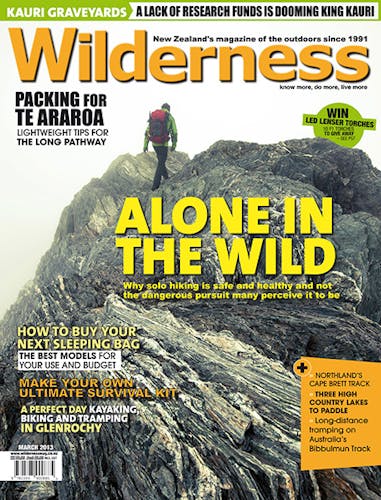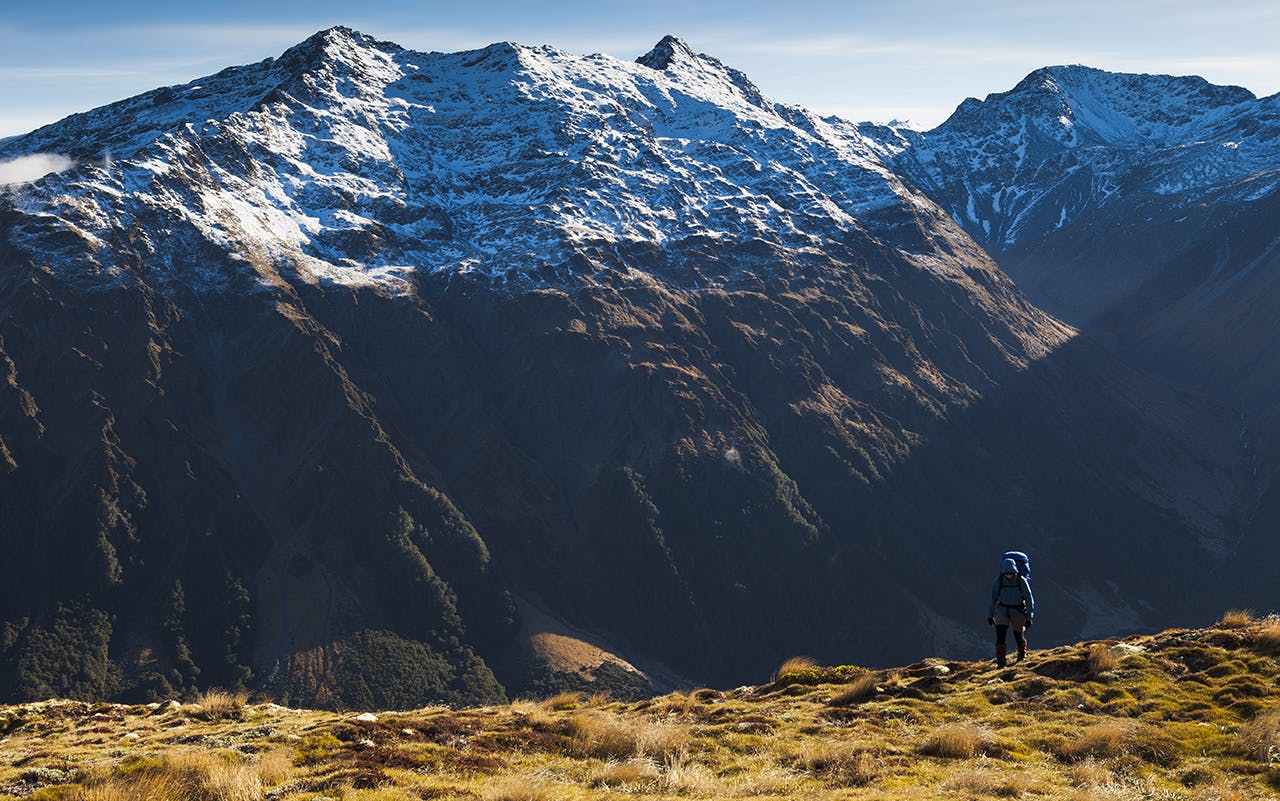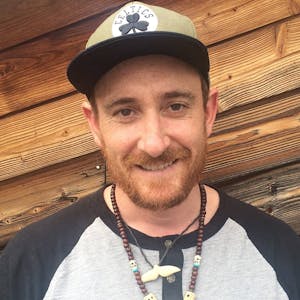Every time someone dies alone in the backcountry media reports often blast solo tramping as dangerous and irresponsible. But going alone might be better for you than you think
Heavy rain was hammering Graham Sutherland who – dirty, soaked and tired – had been alone for nine days.
He was on the last day of Rakiura/Stewart Island’s North-West Circuit and other than a lone German tramper heading in the opposite direction, he hadn’t seen a soul for four days.
You might assume he was having a miserable time, but that would be wrong.
It was a day of unforgettable euphoria and one that remains vivid in his memory eight years later. But Sutherland struggles to explain why.
“I think it’s close to the idea of oneness,” he says with slight hesitation, not really happy with the word ‘oneness’ to describe his experience. “The bush really comes alive when it’s raining hard and I felt so good walking with the rain falling on me.
“It seemed so natural and made me feel really alive as well.
“I’m sure if I was tramping with others I would not have felt that experience as strongly and for as long as I did.”
Eight years later, just talking to me about this day motivates him to plan his next solo tramp.
“I’m not a spiritual person, but solo tramping is probably the closest I get to it,” Sutherland says. “Certainly, I feel I have a deeper connection with my surroundings and the Earth.”
Sutherland, 45, has been a soloer since 1998 when he moved to Wellington. Going solo was a necessity; he had time in the week to go tramping, but no one to go with. So he went on his own and not only discovered that he liked it, but eventually that he preferred it.
Before long he was soloing in the Tararua Ranges every week and on longer trips once a month.
“It’s not just about being on your own, it’s more about the purity of the experience, having nothing else to distract you from nature,” he says. “It’s one of those things you get a taste for and you start doing a bit more of until you start wanting to do bigger tramps alone.”
Sutherland was so intrigued by solo tramping he decided do his master’s thesis on it while studying at Victoria University.
He completed Going solo: A study of solo tramping in New Zealand in 2002 after researching the topic for two years.
It discusses who and how many people are doing it, some of their experiences and an overview of its place in New Zealand’s outdoor culture.
It credits ‘Mr Explorer’ Charlie Douglas as possibly New Zealand’s first recognised solo tramper.
Douglas lived from 1840 to 1916 and explored South Westland’s mountains and valleys, often on behalf of the New Zealand Surveying Department, but also to satisfy his own fascination with the backcountry.
Sutherland says Douglas was a contemporary of American philosopher and naturalist Henry David Thoreau and like Thoreau waxed lyrical about his wilderness contemplations in his journals.
‘Fools say that knowledge can only be acquired by books and men – cribbing, as it were, other people’s thought – and call me a fool and even worse for wasting my life in mountain solitudes, simply because I don’t open up mines of gold and silver,’ Douglas wrote in one entry. ‘I have now been wandering about the uninhabited parts of New Zealand for over five and thirty years, always finding something in nature new to me and the world.”
Since the time of Mr Explorer Douglas, as he came to be known, many have gone alone into the hills in search of solitude, peace and quiet and a deeper connection with nature.
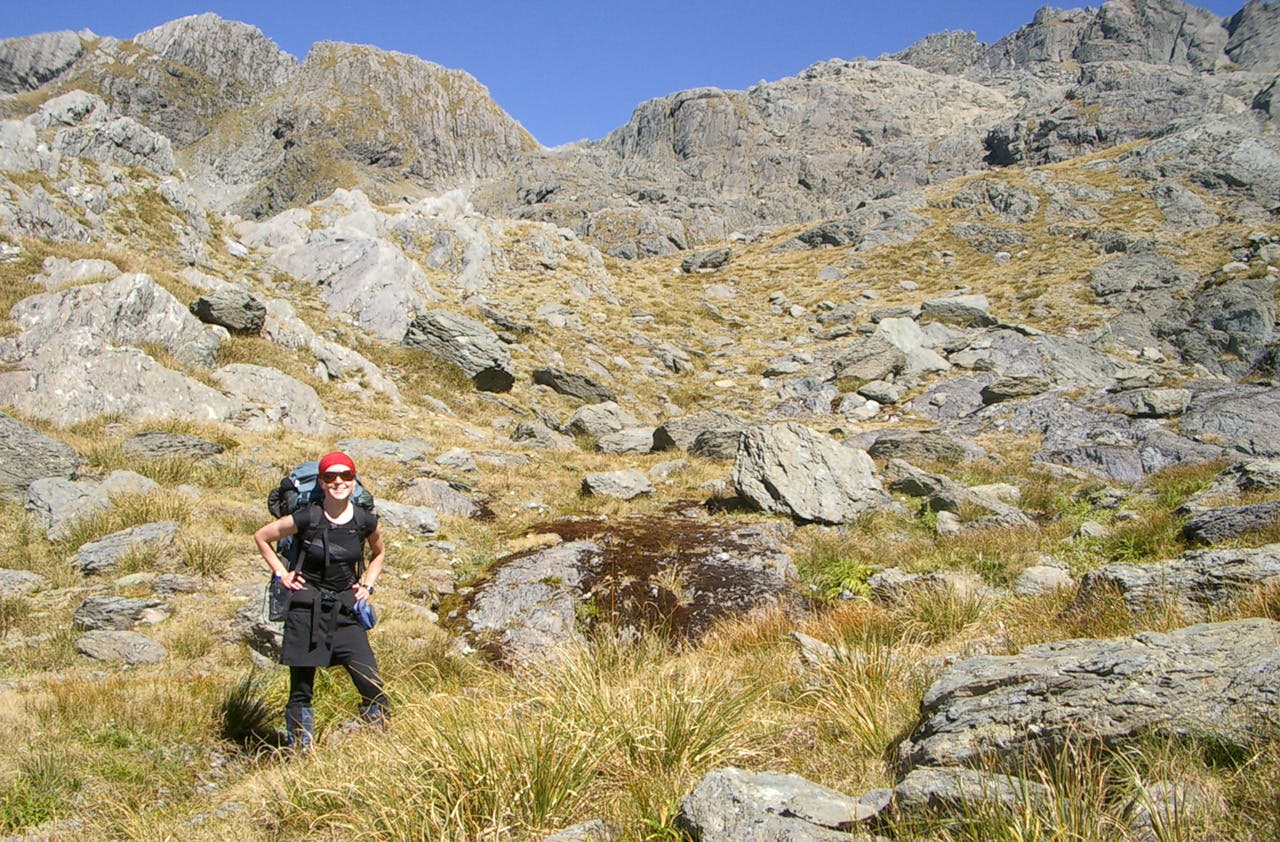
Lauren Schaer says she feels safer when tramping on her own – she’s more alert and doesn’t shirk responsibility. Photo: Supplied
For some, this might sound extreme, the sort of activity only a handful of oddballs would pursue, but according to Sutherland’s thesis more Kiwis are soloing than you might expect.
Sutherland analysed hut books from the Tararua Ranges from periods in the 1990s to get an understanding of the number of solo trampers.
Based on this analysis, solo trampers represented about 10 per cent all the visitors to the huts surveyed. For some huts the percentage was higher, reaching up to 13 per cent. His findings mirror a survey run by Wilderness in 2011. Of the 636 people who participated, 13.84 per cent, said when they go tramping they most often go alone. The biggest chunk, 74.69 per cent of the survey’s participants, said they go with friends and family.
Sutherland’s thesis concluded that solo trampers may represent about seven per cent of trampers visiting New Zealand’s backcountry. He is quick to point out there are serious limitations to his study, however. Rather than being a definite percentage, the study is only an indicator. But the figure of about 10 per cent matches his observations while out in the hills.
Two of the themes he decided were too complex for his thesis were the motivations for why people go solo tramping and the benefits of it.
A quick search on Google Scholar reveals a rucksack worth of literature on solo wilderness experiences; the motivations and benefits, psychological and physical.
Linked to this area of research is the academic and popular literature on solitude. After all, to go solo tramping for days, often not seeing another person for the duration, implies at least a tolerance of and at most a profound need for solitude.
Wilderness started a discussion about soloing on Facebook in January and 19 people quickly chimed in, saying why they enjoyed it. Nine soloers got in contact and all confessed one of the reasons they go solo tramping is because they have a need for solitude.
However, Hokitika-based soloer 52-year-old Mark Mellsop-Mellsen takes it one step further. He says humans have evolved to be a social animal so solitude, naturally, for many people is a form of suffering, but it’s a form of suffering that we need.
“We live in a society that has decided any form of suffering is bad, but a lot of people would benefit from suffering a bit of solitude,” says Mellsop-Mellsen who has been soloing for 29 years. “It has been an integral part of the Outward Bound programme for many years, so the benefits are recognised.
“In Buddhist culture suffering is seen as a positive as it gives everything context and makes the rest of life better.
“If you make a choice to not push it away as society says you should, you will lead a richer life.”
Just in case you’re thinking this is a lot of eccentric waffle, there is plenty of research to support the benefits of solitude.
Ester Buchholz, psychologist and author of The Call to Solitude: Alonetime in a world of attachment, describes time spent alone as having a similarly restorative affect on the brain as sleep which she calls ‘enforced solitude’.
‘Being alone gives us the power to regulate and adjust our lives,’ she writes. ‘It can teach us fortitude and the ability to satisfy our own needs.
‘A restorer of energy, the stillness of alone experiences provides us with much-needed rest.
‘It brings forth our longing to explore, our curiosity about the unknown, our will to be an individual, our hopes for freedom.
‘Solitude is an important route to creativity; indeed, research on creative and talented teenagers suggests that the most talented youngsters are those who treasure their solitude.
‘Alonetime is fuel for life.’
And, she says, all the better if that alone time happens in the hills, which Thoreau referred to as the ‘tonic of wilderness’.
Cantabrian IT engineer and solo tramper 34-year-old Dennis Radermacher sums it up best.
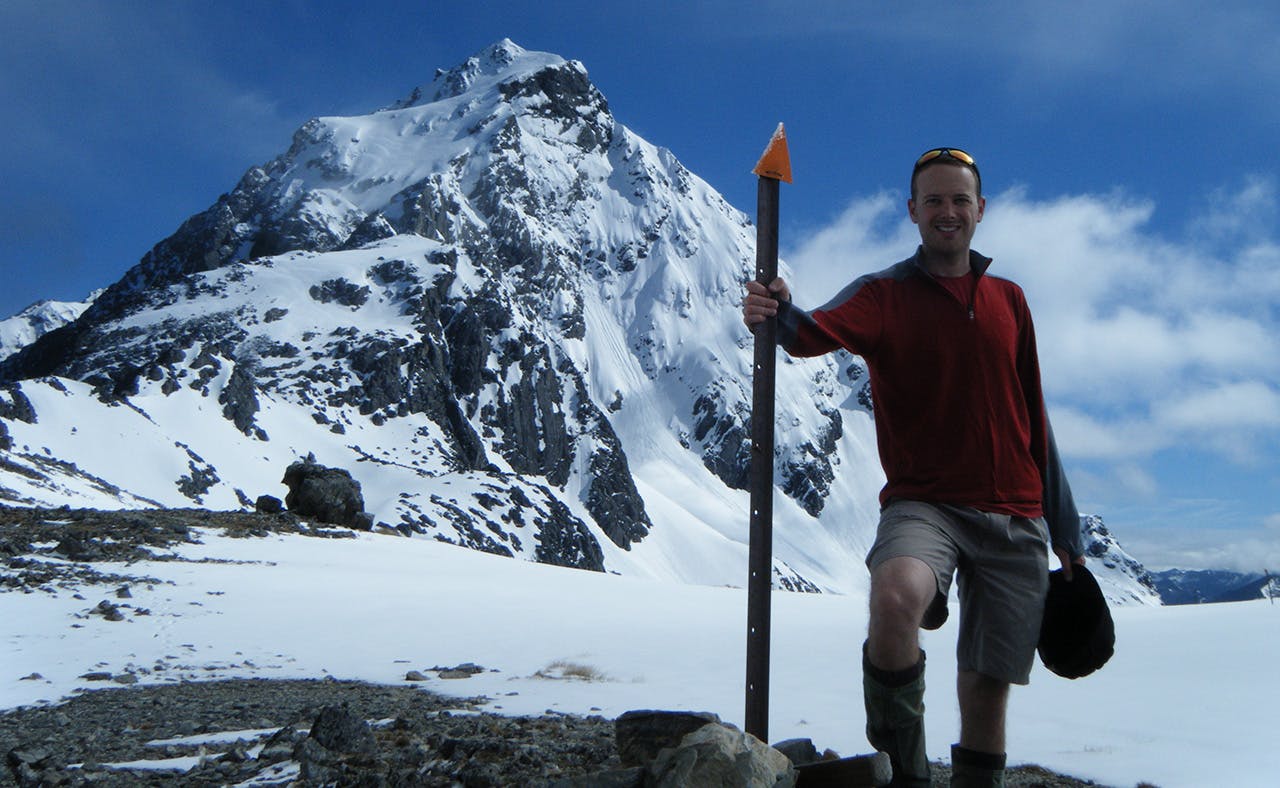
David Short solo tramps for the freedom it provides to choose his own speed, camp where he likes and change plans on a whim. Photo: Supplied
“It’s like sleep, a mental cleanup process, and time to reflect on things that in everyday life we don’t take the time for,” says Radermacher, who moved to New Zealand from Germany three years ago.“I believe all of us, even the most social specimens, need a bit of solitude to stay sane.
“There’s a part-time hermit in all of us.”
Radermacher regularly engages his inner hermit on solo weekend tramps in Canterbury. His favourite hideaways are around the Ashburton Lakes, Lake Coleridge and Porters Pass areas.
He likes to park his car somewhere far removed from the rest of humanity and go on off-track journeys into the high country.
Going alone means fewer distractions, more time for photography, being able to go at his own pace and to push his skills as far as he likes.
Radermacher occasionally goes with a friend, but he says few want to join him on his explorations.
He tried going with a tramping group, but it disrupted the quiet and solitude he seeks from the wilderness.
Most of the nine soloers I spoke to made similar points: they liked soloing because of the freedom it gives them to decide their own pace, when and where they stop and go without the need to consult others, having more time for photography, to have some time to themselves and to feel closer to nature.
Most of them said tramping with a group is, at least, sometimes irritating because of the consultation involved, group dynamics and the different pace and fitness levels of individual group members.
Faster walkers have to hang around and wait for slower people who often feel they have to hurry to keep up with others.
Most also said when they go alone they tend to do longer and more difficult trips than they’d do with others.
Radermacher makes pushing himself a sport on his solo trips. He says this is a bad habit and one that led him into a few dicey situations; narrow, steep gullies where his chances of being found if he came to harm would have been close to nil.
“I was just in a situation like that a little while back when I was climbing a spur I should not have attempted without someone belaying me,” Radermacher says. “For some reason I only realised that when I was up way too high.
“Doubling back and climbing down was no fun.
“You’re at a much higher risk of making bad judgement calls going alone.”
This is a common criticism made of solo tramping: a group of trampers is more likely to make safer decisions because of having more eyes and ears on a situation and more robust discussion.
All but two of the nine soloers interviewed disagreed with this, though. Some said going solo is safer.
But safer doesn’t always mean safe. Lauren Schaer, for example, had a close call while she was soloing in Nelson Lakes National Park. She was crossing a still, but deep stream when she lost her footing and found herself floating towards a raging river. With difficulty, she managed to kick her way towards a thin branch and pulled herself onto the bank. The experience gave her a good lesson, she says.
Schaer, 35, likes to do five-day solo trips, usually in Mt Aspiring National Park because of the countless route options. For her, solo tramping is a form of meditation and gets her away from the “clamour and insanity of modern life”.
“The thing is,” she says, “I generally feel safer on my own.
“Yes, if I fall and hit my head or can’t set off my PLB then there’s a chance having a second or third person might have helped, but what about all the dumb decisions groups make?
“I’ve wandered the wrong way when I’ve been deep in conversation with a tramping partner. I’m more alert when I’m tramping by myself. I don’t shirk responsibility; it’s all on me.”
Mark Mellsop-Mellsen says the phenomenon of group-think – the tendency of groups to make decisions based on maintaining harmony and conformity rather than on the best outcome – can make tramping in a group more dangerous than going solo.
He says the personal accountability required to go solo raises his focus to a higher level. But, he adds, the judgement and skills to go solo can only be learned in a group setting.
Like most of the other soloers interviewed, he takes a personal locator beacon on his solo trips, more for the peace of mind of his family than for himself.
Most said they carefully plan their trips, always leave their intentions and enter their names in hut books.
Christchurch Hospital doctor 28-year-old David Short has a Ps motto he lives by: prior preparation and planning prevents piss poor performance.
His first solo trip was over Sawtooth Ridge in Ruahine Forest Park in 2007. He completed the Travers-Sabine Circuit in Nelson Lakes National Park alone in November 2012.
Short tries to do one longer solo trip a year and a few weekend trips.
“I love the adventure and freedom solo tramping gives,” he says. “I can go at my own speed, I can skip huts or change plans and sometimes, if I’m lucky, I get unique experiences with native birds.
“In general, I choose solo trips that stay on track but up to now that has been the only real caveat.”
Another finding to come out of Sutherland’s thesis is that it’s usually more experienced trampers who go on solo trips.
But experience is a difficult quality to pin down because it means different things to different people.
Jonathan Carr has been going on solo trips for 24 years and says he’s suspicious of people who claim to be experienced trampers, but who haven’t done solo trips.
Going solo, he says, is an important part of a tramping career.
Carr, 43, a member of Christchurch Tramping Club, has done solo trips all over the South Island and abroad in China, Australia and Argentina.
“I liken solo tramping to being what a PhD is in the context of education,” he says. “A PhD is a qualification in intellectual independence rather than knowing more about something.
“So it is with solo tramping.
“I don’t think solo tramping is necessary to gain new insight into the environment, it’s more about exploring your motivation, why you love being out there and taking full responsibility for yourself.”
In other words, going solo is way of deepening your love for tramping and learning to be self-sufficient – that’s something all trampers, regardless of who they go with, can agree is a good thing.





